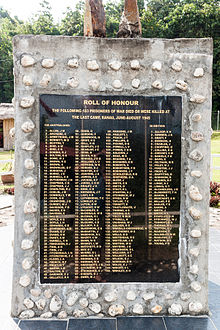Last POW Camp Memorial
The Last POW Camp Memorial is a memorial in Ranau district in the Malaysian state of Sabah that commemorates the victims of the Sandakan death marches . Of 1047 British and Australian prisoners of war, the so-called reached only 189 alive "Last Camp" ( Engl. For "Last camp") in Liwagu Valley in Ranau. Of these 189 people, 153 died in the next six weeks. Another 32 prisoners of war were murdered; four prisoners managed to escape. The memorial was erected on the edge of the former camp .
description
The memorial is located about 8 kilometers south of Ranau on the road to Tambunan above the Liwagu Valley . The memorial is fenced and open to the public from 9 a.m. to 5 p.m.
A concrete stele is located on a large concrete surface in the shape of a star. 1047 river stones are embedded in the concrete surface. They come from the Sungai Liwagu that flows by below the memorial. That was where the camp was located. Each of these stones on the concrete surface symbolizes one of the prisoners of war who started the death march from Sandakan.
The stele is also made of concrete. Another 183 river stones are embedded in the concrete of the stele; one for every prisoner of war who died in this camp on the Liwagu River. There are four furrowed stone slabs on the memorial stone. They stand for the four POWs who managed to escape during the death march.
A stone slab made of polished granite is embedded on each of the four sides of the stele. Three panels tell the story of the death marches in English, Chinese and Malay. The names of the 183 prisoners of war are immortalized on the fourth granite slab.
The granite memorial stone shows the following inscription in English:
|
RANAU NUMBER 2 PRISONER OF WAR JUNGLE CAMP |
History of the memorial
The discovery of the camp goes back to the historian Lynette Silver. The entire area, which includes the valley floor with the original camp and the memorial above it, is private property. However, the owner, Othman Minudin, decreed that the site should remain as a memorial “forever” . The decree also includes the obligation that the actual camp site remains untouched nature. The memorial stone was presented to the public on August 27, 2009 - exactly 64 years after the last 15 prisoners of war were murdered - by the Minister for Tourism Datuk Masidi Manjun, by the land owner Othman and by Lynette Silver as the representative of the relatives. In a symbolic ceremony, a member of the British and Australian POW completed the memorial by walling the last two river stones into the star-shaped concrete surface.
POW route
The “Last POW Camp Memorial” is a station on the “POW Route”, on which the prisoners of war marched in the area during the three death marches. The route begins in Sandakan and ends at the "Last Camp" near Ranau. The stations of the route are marked with a sign.
literature
- Lynette Ramsay Silver: Sandakan - A Conspiracy of Silence , 4th Edition, Sally Milner Publishing Pty, 2011, ISBN 978-1-86351-424-8
Web links
Individual evidence
- ↑ a b c Tony Stephens: Unearthed: A final message from Sandakan's doomed soldiers ( Memento of the original from March 23, 2012 in the Internet Archive ) Info: The archive link was inserted automatically and has not yet been checked. Please check the original and archive link according to the instructions and then remove this notice. ; Accessed October 11, 2012
- ↑ The Last Camp Memorial ( Memento of the original from March 23, 2012 in the Internet Archive ) Info: The archive link was inserted automatically and has not yet been checked. Please check the original and archive link according to the instructions and then remove this notice. ; Accessed October 12, 2012
Remarks
- ↑ Translation: In 1945 more than 1000 Australian and British prisoners of war were forced by the Japanese occupiers to walk 250 kilometers through the jungle from Sandakan to Ranau. In June the 189 men who survived these death marches were crammed together in the valley below, the "Last Camp". The conditions there were appalling and six weeks later all but 32 were dead. Seventeen of these were murdered on August 1st. The remaining fifteen were killed on August 27, twelve days after the war ended. Another 1,400 prisoners died in the Sandakan POW camp. Six Australians, four of them from this camp, escaped and were hidden by locals who risked their lives. They were the only survivors.
Coordinates: 5 ° 54 '28.1 " N , 116 ° 38' 52.5" E




